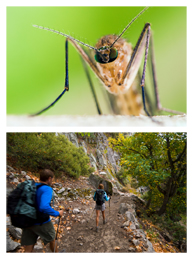
House Flies (Muscidae)
Flies belong to the same order (Diptera) as mosquitoes. Some species are dangerous because they contaminate food, others bite or suck human blood causing painful wounds and transmitting diseases.
The Muscidae are a large family of flies typified by three species – the common house fly (Musca domestica) whose larva live in rotting matter and dung. The lesser house fly (Fannia canicularis) which tends to fly indoors. Both species do not bite and are more a problem of hygiene and a nuisance. This distinguishes them from the third species known as the common stable fly (Stomoxys calcitrans) or biting house fly.
Stable flies are not tied to livestock – they will also bite people. They remain on their hosts only while trying to feed and travel widely in search of hosts or breeding sites.
In contrast to other species, the mouthparts of both male and female members of this family are essentially identical and both sexes bite. Also their mouthparts are constructed on an entirely different principle. They force the entire proboscis into the skin like a needle. Small spines at the tip of the proboscis can rasp a hole in the flesh and pull the proboscis deeper, causing painful effects to the victim.
Larvae of the stable fly develop in cattle dung or any other decomposing vegetable refuse, such as lawn clippings, refuse from packing plants or waterweed cast ups. Stable flies develop rapidly and may complete several generations each summer. Unlike members of the preceding families, stable flies hibernate in the pupal stage. Stable flies can transmit bacteria with their mouthparts causing f.e. tularaemia and anthrax. They may bite several animals many times before feeding to completion.
Flies belong to the same order (Diptera) as mosquitoes. Some species are dangerous because they contaminate food, others bite or suck human blood causing painful wounds and transmitting diseases.
The Muscidae are a large family of flies typified by three species – the common house fly (Musca domestica) whose larva live in rotting matter and dung. The lesser house fly (Fannia canicularis) which tends to fly indoors. Both species do not bite and are more a problem of hygiene and a nuisance. This distinguishes them from the third species known as the common stable fly (Stomoxys calcitrans) or biting house fly.
Stable flies are not tied to livestock – they will also bite people. They remain on their hosts only while trying to feed and travel widely in search of hosts or breeding sites.
In contrast to other species, the mouthparts of both male and female members of this family are essentially identical and both sexes bite. Also their mouthparts are constructed on an entirely different principle. They force the entire proboscis into the skin like a needle. Small spines at the tip of the proboscis can rasp a hole in the flesh and pull the proboscis deeper, causing painful effects to the victim.
Larvae of the stable fly develop in cattle dung or any other decomposing vegetable refuse, such as lawn clippings, refuse from packing plants or waterweed cast ups. Stable flies develop rapidly and may complete several generations each summer. Unlike members of the preceding families, stable flies hibernate in the pupal stage. Stable flies can transmit bacteria with their mouthparts causing f.e. tularaemia and anthrax. They may bite several animals many times before feeding to completion.

